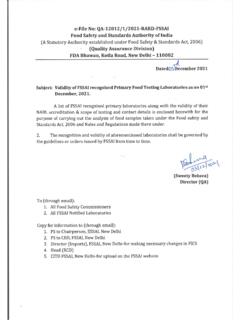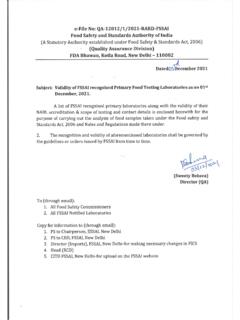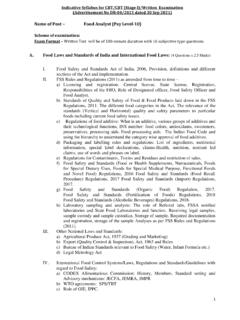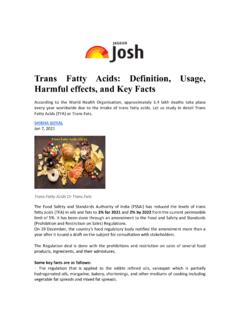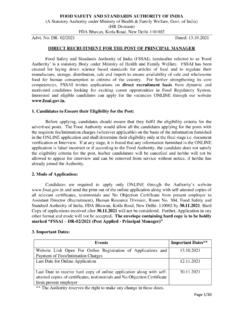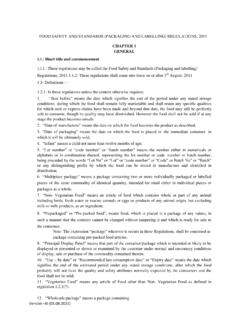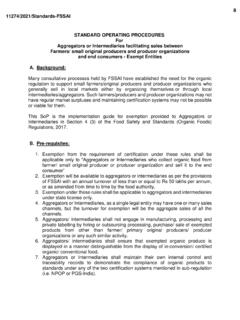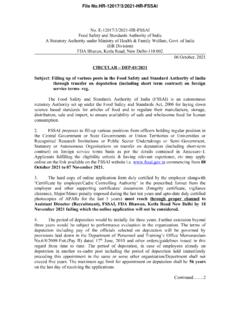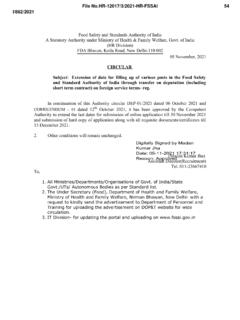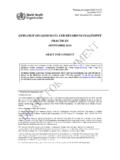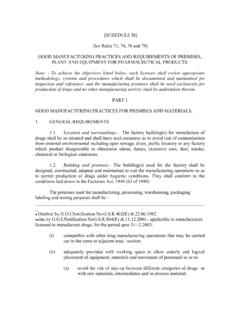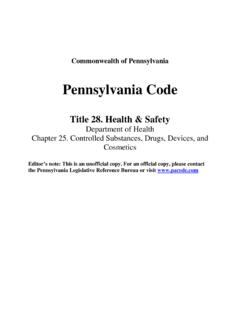Transcription of FOOD INDUSTRY GUIDE TO IMPLEMENT GMP/GHP …
1 61 GUIDANCE DOCUMENT food SAFETY MANAGEMENT SYSTEMS food INDUSTRY GUIDE TO IMPLEMENT GMP/GHP requirements MILK AND M ILK PRODUCTS1 food INDUSTRY GUIDE to IMPLEMENT GMP/GHP requirements MILK AND MILK PRODUCTS Based on Part II &III of schedule 4 of food Safety & Standards (Licensing & Registration of food Businesses) Regulation, 2011 First Edition February 2018 Online available at Disclaimer It is to be noted that this guidance document does not intend to replace any legal provision of food Safety & Standard Act, 2006 & regulations thereunder. Further, wherever the provision of this document conflicts with schedule 4 of food Safety & Standard (Licensing and Registration of food Businesses) Regulation, 2011 or any other regulation under food Safety & Standard Act, 2006 for that matter, the provision given in the regulations shall prevail. 2 PREFACE This Guidance Document on food Safety Management System (FSMS) is prepared with the intent to provide implementation guidance to food businesses (especially the small and medium businesses) involved in manufacturing /processing, packing, storage, distribution , retail and transportation of food Supplements, to ensure that critical food safety related aspects are addressed throughout the supply chain.
2 This document contains practical approaches which a business should adopt to ensure food safety; however, manufacturers may adopt higher or stringent levels, depending on the needs & complexity of operation. The use of this guidance is voluntary and food business operators may comply with the requirement of the regulation according to other established best practices . It is important that food handlers involved in whole supply chain of Milk and Milk products are trained appropriately to IMPLEMENT the good manufacturing practices and good hygiene practices to ensure food safety. We acknowledge the contribution of the experts from the technical panel of FSSAI for developing this document. Pawan Agarwal CEO, FSSAI 3 SCOPE This document is applicable for food businesses involved in the Dairy sector which includes all milk and milk products: a)Liquid Milkb)UHT milk, condensed milk, fermented milk and flavoured milkc)Ghee, butter, creamd)Dairy Whitener (WMP & SMP)e)Curd, yoghurt, butter milk, paneer, cheeseAll the above product categories may or may not be handled by the same facility.
3 Hence, based on the product category handled, a food supplement INDUSTRY could use the guidance document accordingly as per the operations applicable to them. The document is divided into five main sections. The first section gives an overview of the dairy INDUSTRY in India along with the rising need for food safety in the sector. The second section contains guidance for implementation of good manufacturing practices and good hygiene practices as outlined in Part III of schedule 4 of food Safety & Standard (Licensing & Registration of food Businesses) Regulation, 2011. The document has all requirements where compliance is essential and obligatory for food businesses and in such cases the word shall is used. In addition, certain good practices are also strongly advised for food safety operation & in such case should is used.
4 The third section of this document is recommendatory in nature and provides the basic knowledge and criteria for implementation of Hazard Analysis and Critical Control Point (HACCP) system by the food businesses. This section includes the manufacturing flow chart & two tables: Hazard Analysis and HACCP Plans. Tables of Hazard Analysis is expected to help the INDUSTRY to identify the food safety risks related to each processing step, to identify the Critical Control Points (CCPs) along with recommended corrective actions and other related information. Sample HACCP Plans have been taken from some established practising dairy industries. These plans could be used as reference by the INDUSTRY and modified or altered based on their operations. The fourth section provides an inspection checklist for food Business Operator to audit their facility & operations. The FBOs can evaluate themselves based on the indicative scoring.
5 The last section gives important templates and forms which will be required by FBOs to maintain the records. This includes mandatory forms as prescribed by FSSAI & few templates for maintaining records of processes critical for food safety. 4 TECHNICAL EXPERTS, REVIEWERS & CONTRIBUTORS Dr. Bhallla Director, M/S Gopaljee Dairy Foods Pvt. Ltd. Mr. Kuldeep Sharma Suruchi Consultants Ms. Shabnam Chopra In-charge QA, Head PCDF, Lucknow Mr. Keyur M. Ghodke GCMMF Ltd.,Amul, Anand Dr. Kajal Debnath Head Regulatory Affairs, Mother Dairy Dr. D K Sharma GM (QA & PPD), NDDB Mr Vijay Gaur Sr. Regulatory Affairs Manager, Danone India Dr. Anirudha K. Chhonkar Corporate Regulatory Advocacy Manager, Nestle India Ltd. Dr. B B Garg Consultant Mr. Gupta DC(DD), MOA & FW DADF Dr. Rubeena Shaheen Director, FSMS Div., FSSAI Dr.
6 Sujata Singh Assistant Director, FSMS Div., FSSAI 5 Contents Glossary .. 7 A. OVERVIEW OF MILK INDUSTRY IN INDIA .. 8 B. PRE-REQUISITE PROGRAMMES .. 9 I. ESTABLISHMENT DESIGN AND FACILITIES .. 10 1. Location and Surroundings .. 10 2. Building Design, construction & Layout .. 10 3. Equipment Design and Installation .. 12 4. Facilities/ Utilities .. 13 II. ESTABLISHMENT - CONTROL OF OPERATIONS .. 20 1. Supplier Approval and food receipt .. 20 2. Storage and Material Control .. 20 3. Milk Processing .. 21 4. Milk and Milk Product Packaging and Warehousing .. 24 5. Rework & Control of Non-Conforming Product .. 26 6. Transportation & distribution .. 27 7. Traceability and Recall .. 29 8. Quality Control & Testing .. 30 III. ESTABLISHMENT - MAINTENANCE AND SANITATION .. 36 1. Cleaning and Sanitation .. 36 2. Maintenance .. 41 3. Animal and Pest control .. 43 4. Drainage and Waste Disposal .. 45 IV.
7 ESTABLISHMENT - PERSONAL HYGIENE AND EMPLOYEE FACILITIES .. 46 1. Health Status and Illness & Injury .. 46 2. Personal Cleanliness .. 46 3. Personal Behaviour .. 47 4. Work wear and Grooming .. 47 5. Visitor Control .. 47 V. ESTABLISHMENT - PRODUCT INFORMATION AND CONSUMER AWARENESS .. 48 1. Product information and Labelling .. 48 6 2. Consumer Awareness and complaint Handling .. 48 VI. ESTABLISHMENT - TRAINING AND MANAGEMENT .. 49 1. Awareness and Responsibilities .. 49 2. Training Program .. 49 3. Instruction and supervision .. 49 4. Refresher Training .. 49 5. Management and Supervision .. 49 VII ESTABLISHMENT AUDIT, DOCUMENTATION AND RECORD KEEPING .. 51 1. Self-evaluation and review .. 51 2. Documentation and records .. 51 C. SUBCONTRACTING OPERATIONS .. 53 1. Terms of Agreement/ Contract .. 53 2. Technical Agreement .. 53 D. HACCP IMPLEMENTATION .. 54 I. INTRODUCTION TO HACCP .. 54 II. APPLICATION OF HACCP SYSTEM.
8 56 1. HACCP Implementation steps .. 56 2. HACCP 60 E. INSPECTION CHECKLIST .. 73 F. PROFORMAS/TEMPLATES .. 76 ANNEXURE 1: GMP and GHP to be followed at the level of village collection, MCC and BMC level .. 88 ANNEXURE 2: Sample design and layout of milk processing plant .. 89 ANNEXURE 3: Floors for dairy manufacturing facilities .. 92 ANNEXURE 4: General GUIDE to packaging material .. 93 ANNEXURE 5: Milk Condensate Recovery .. 94 ANNEXURE 6: Recommended MILK CONDENSATE RECOVERY (CoW Water RO Plant) .. 95 ANNEXURE 7: Relevant BIS Standards adopted in FSSAI .. 97 7 Glossary FBO food Business Operator UHT Ultra High Treatment CAGR Compound Annual Growth Rate SOP Standard Operating Procedure IPM Integrated Pest Management MS Mild steel COA Certificate of Analysis QC Quality Control CIP Cleaning In Place CAPA Corrective Action Preventive Action SS Stainless Steel FIFO First In First Out FEFO First Expired First Out FMFO First Manufactured First Out HACCP Hazard Analysis & Critical Control Point CCP - Critical Control Point RH Relative Humidity VLC Village Level Collection BMC Bulk Milk Cooler MCC Milk Chilling Centre SMP Skim Milk Powder WMP Whole Milk Powder 8 A.
9 OVERVIEW OF MILK INDUSTRY IN INDIA India has been the leading producer and consumer of dairy products worldwide since 1998 with a sustained growth in the availability of milk and milk products. Dairy activities form an essential part of the rural Indian economy, serving as an important source of employment and income. India also has the largest bovine population in the world. However, the milk production per animal is significantly low as compared to the other major dairy producers. Moreover, nearly all of the dairy produce in India is consumed domestically, with the majority of it being sold as fluid milk. On account of this, the Indian dairy INDUSTRY holds tremendous potential for value-addition and overall development. According to the latest the dairy market in India reached a value of INR 7,916 Billion in 2017.
10 Despite this, the majority of the Dairy INDUSTRY in India is still highly unorganised dominated by small and marginal dairy farmers. As the INDUSTRY possesses huge untapped opportunities, it has attracted a number of private companies and investors. In addition, the Indian government has also been taking initiatives towards the development of the dairy sector by providing support to the milk cooperatives and rural milk producers. Moreover, the sustained growth of the Indian economy has led to a rise in the spending power of consumers, rapid urbanisation as well as changes in the dietary patterns. With an increase in the working population, hectic lifestyles and increasing health consciousness among the consumers, there has been a shift towards healthy and ready-to-eat dairy products. Along with offering profitable business opportunities, the dairy INDUSTRY in India serves as a tool of socio-economic development.

